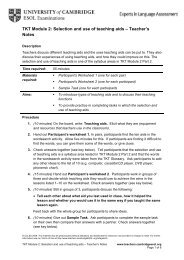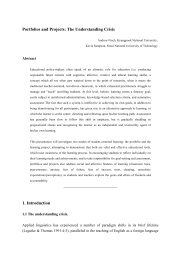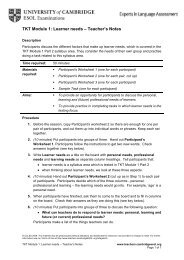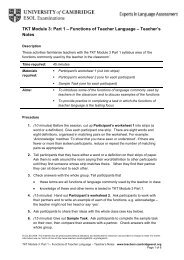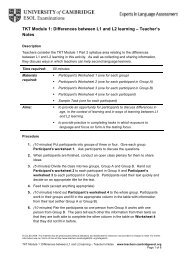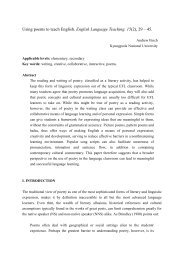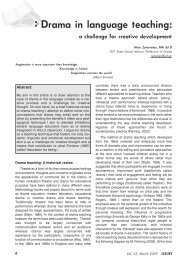here - Finchpark
here - Finchpark
here - Finchpark
You also want an ePaper? Increase the reach of your titles
YUMPU automatically turns print PDFs into web optimized ePapers that Google loves.
children are. However, not all research shows the positive effects of bilingualism. Before 1960,t<strong>here</strong> were an overwhelming number of studies that highlighted the negative effects ofbilingualism on children (see Grosjean, 1982: 220-27; Romaine, 1995: 107). Observers notedmany problems with language development of bilingual children, such as restricted vocabularies,limited grammatical structures, unusual word order, errors in morphology, hesitations, stuttering,and so on. Some have even argued that bilingualism could impair the child's intelligence and leadto split personalities. How can these contradictory findings be explained?In a comparative analysis of selected studies, Swain and Cummins (1979) report that the positiveeffects are usually associated with language majority children in immersion programs, w<strong>here</strong>knowledge of two languages is valued highly, w<strong>here</strong> the children learn the L2 without losing thefirst and w<strong>here</strong> the parents are of relatively high socioeconomic status. For example, middle-classEnglish-speaking parents in Canada who enrol their children in French immersion programschoose to do so because of the perceived benefits of knowing another language. The educationalgoal of such programs is the enrichment of children from the dominant group through instructionin a second language. The children's L1 (English in this case) is respected and is in no danger ofbeing replaced by the L2 (French). Teachers in immersion programs have high expectations forchildren's achievement and t<strong>here</strong> is usually a significant level of parental involvement and support.French is considered a valuable addition to the children's existing linguistic repertoire and the mostusual outcome is proficiency in both English and French. This type of bilingual developmentcorresponds to Lambert's (1977) 'additive bilingualism'.In contrast, negative effects are found with linguistic minority children who are forced to learn themajority language and are not encouraged to maintain their mother tongue and whose socialenvironment does not induce learning. The bilingualism of linguistic minority children is differentfrom that of linguistic majority children because the home language is not supported in school andthe society. Minority children usually experience enormous pressures to learn the societal languageand feel that they need to give up their L1 in order to be accepted by the mainstream society. Inschool, the bilingualism of linguistic minority children is considered a handicap, and children'sprior linguistic and cultural knowledge is deemed irrelevant or undesirable. The message given bythe educational and social establishments is that immigrants need to be rapidly integrated into themainstream society, which entails abandoning the ethnic language and culture. It is small wonderwhy so many immigrant children end up losing their mother tongue and become monolingual inthe societal language. This situation corresponds to Lambert's (1977) 'subtractive bilingualism'.4. Literature ReviewMany issues involvedStudies concerning HL acquisition and instruction have become a sub-discipline in the field ofapplied linguistics, a sub-discipline w<strong>here</strong> the researchers examine the linguistic, pedagogical,social, and political issues related to HL learners (e.g., Kondo- Brown, 2003, 2005; The UCLASteering Committee, 2000; Valdes, 1995,2005; Webb & Miller, 2000).In the 1980s and early 90s, the personal benefits of HL development for students with immigrantbackgrounds were widely discussed in educational research. For example, the US.-based researchon students from immigrant backgrounds suggests that HL development is interconnected withpositive ethnic identity development and academic success (e.g., Delgado-Gaitan & Trueba, 1991;Gibson,1988; Golden, 1990; Nielsen & Lerner, 1986: Trueba, Cheng, & Ima, 1993; Portes &Rumbaut, 1990). Likewise, earlier Canada-based studies about the educational outcomes of HLdevelopment are positive, suggesting that HL development may actually help language minority




